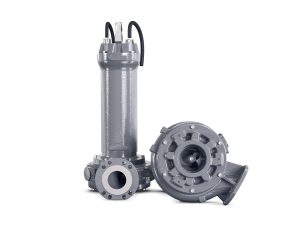Tsurumi: Water Pumps to be Used with Thick and Hard Liquids – Frequent Cleaning is a Must

The inlet opening at the bottom of the pump: at first glance, everything looks good (Image source: Tsurumi (Europe) GmbH))
Even the daily operating routine is an ordeal for the pumps. All suspensions with cement, mortar, slurry and other hard ingredients have a highly abrasive effect on the hardware used. Moreover, they can leave rock-hard marks if not cleaned enough.
"Even the best pump can become unusable by the next shift," warns Stefan Himmelsbach from the pump manufacturer Tsurumi in Düsseldorf, Germany. "In the worst case, concrete residues harden in the pump body". The pump unit is then hardly salvageable. Therefore, regular cleaning is mandatory, not optional. This may have to be done daily if the pump is to be kept in the best possible condition.
Himmelsbach describes how best to proceed - especially if the cleaning status is unclear and you want to do it "properly now".
Soak in advance
The work is made easier by "soaking" the pump overnight. A discarded barrel can be used for this purpose. Fill it with water and scale or limescale remover according to the instructions. A typical mixing ratio is 1:10 when used overnight. The process dissolves hardness builders and cleans the surfaces. Beware of gas and odour development! However, the organic components of the mixture are usually biodegradable.
The next morning, the pump is cleaned with a high-pressure cleaner. Then the electrical safety is checked.
Here, the power cable entry into the housing must be examined carefully. Tsurumi pumps offer a small advantage here, as each individual conductor is encapsulated in synthetic resin and thus hermetically sealed. Damage due to creeping water is thus practically excluded. Generally speaking, when it comes to electrics, it is not so much the actual operating environment that is relevant, but the handling of the unit. The pump is often pulled by the cable instead of the handle - and the cable gets overstretched. In this respect, always check the entire cable in full length as well.
Look at oil and technology
Then it's time to check the lubricating oil. The oil drain is located on the housing: unscrew it and visually check the oil. If the colour and consistency look suspicious, or water is visible, this indicates a leak. Often cause is the lip seal, which is easy to replace. If not, also check the mechanical seal on the pump shaft, but this is a little more time-consuming. If necessary, fill up or replace the oil. For best environmental protection, Tsurumi pumps can also be operated with bio degradable oil.
When visually inspecting the mechanics, look down: Are the inlet strainer, impeller and wear plate intact? Be sure to brush out any material that has adhered to the pump. If pump operation has left stubborn deposits or deep abrasion marks, replace the parts. With Tsurumi, this can be done quite quickly, as the pumps are designed in modular construction and much of the work can be done by the user with standard tools. But do not dismantle the pump completely.
The important points have already been dealt with. Now check the function of the unit. A water meter for checking the flow rate according to the type plate is a good idea. To be on the safe side, you should also carry out a pressure test (of the oil chamber). For this purpose, use a pressure gauge that is attached to the oil drain with standard fittings. This is what the experts at Tsurumi do as well. One bar of air pressure is sufficient to check whether the (replaced) seals are all seated correctly.
The pump should then be ready for the next use. If you follow the basic recommendation to flush your dewatering pumps with clear water rather more than too little, the service life of the pumps should be significantly extended.
Source: Tsurumi (Europe) GmbH







